In a world increasingly desperate for sustainable energy solutions to combat climate change, a remarkable breakthrough from The Hong Kong Polytechnic University (PolyU) offers a glimmer of hope with their innovative research. Researchers at this esteemed institution have set their sights on revolutionizing solar technology by developing perovskite/silicon tandem solar cells (TSCs) with an ambitious goal of achieving 40% energy conversion efficiency. Led by Prof. Li Gang and Prof. Yang Guang from the Department of Electrical and Electronic Engineering, this cutting-edge project not only pushes the boundaries of third-generation solar technology but also aligns directly with global carbon neutrality objectives. Their work, detailed in a comprehensive study published in a leading scientific journal, addresses critical technical challenges while supporting high-energy sectors like artificial intelligence with stable, renewable power. This pioneering effort underscores a pivotal moment in the quest for cleaner energy, sparking curiosity about how such advancements could reshape the future of sustainability.
Breaking New Ground in Solar Efficiency
The pursuit of higher efficiency in solar cells has long been a driving force behind renewable energy research, and PolyU’s team is at the forefront of this endeavor. Their current benchmark for perovskite/silicon TSCs stands at an impressive 34%, but the target of 40% represents a transformative leap. Such efficiency could dramatically reduce the cost of solar energy, making it a viable alternative for industries with massive power demands. The research focuses on optimizing the unique properties of perovskite materials, which, when combined with silicon, create a tandem structure capable of capturing a broader spectrum of sunlight. This innovative approach maximizes energy conversion, offering a solution that could power everything from data centers to urban infrastructure. Moreover, aligning with global sustainability goals, this advancement promises to cut reliance on fossil fuels, paving the way for a cleaner, greener planet through meticulous engineering and scientific rigor.
Beyond efficiency, the significance of this research lies in its potential to redefine energy accessibility on a global scale. Achieving a 40% conversion rate would not only enhance the performance of solar installations but also make them more compact and cost-effective, requiring less space for the same energy output. This is particularly crucial for densely populated regions where land is scarce. The PolyU team has delved into strategic insights that improve TSC performance by fine-tuning material compositions and device architectures. Their findings suggest that even small incremental gains in efficiency can have outsized impacts on energy economics, lowering electricity costs for consumers and businesses alike. By prioritizing such high-efficiency targets, the researchers are addressing a core challenge in renewable energy: ensuring that sustainable solutions are not just environmentally friendly but also economically competitive with traditional power sources.
Overcoming Barriers to Commercial Scalability
One of the most formidable challenges in bringing TSCs to market is the inherent instability of perovskite materials, which are notoriously sensitive to environmental factors like moisture, oxygen, UV light, and temperature fluctuations. This vulnerability often leads to efficiency degradation over time, posing a significant hurdle for real-world applications. The PolyU researchers are tackling this issue head-on by advocating for rigorous stability testing based on international standards. Their approach ensures that these solar cells can withstand harsh conditions without losing performance, a critical step toward commercial viability. By focusing on long-term reliability, the team aims to bridge the gap between laboratory success and practical deployment, ensuring that TSCs can endure the test of time in diverse climates and settings across the globe.
Scaling from small lab prototypes to large commercial modules introduces additional complexities, such as maintaining uniformity and controlling defects during manufacturing. The PolyU team recognizes that alignment with industrial standards is essential for widespread adoption. Their research emphasizes the need for precision in production processes to minimize variations that could undermine efficiency. Issues like inconsistent material deposition or misalignment in tandem structures can significantly impact performance, and addressing these requires innovative engineering solutions. By prioritizing scalability, the researchers are laying the groundwork for TSCs to transition smoothly into industrial production, ensuring that the technology can meet the demands of large-scale energy projects while maintaining the high efficiency that makes it so promising for future applications.
Prioritizing Sustainability in Solar Innovation
While the cost-effectiveness of perovskite materials makes TSCs an attractive option, the common use of lead in their design raises serious environmental and regulatory concerns due to its toxicity. Recognizing this, the PolyU team is exploring alternative materials that can deliver comparable performance without the ecological risks associated with heavy metals. Additionally, strategies like recycling and lead sequestration are being investigated to mitigate potential harm. This focus on eco-friendly practices reflects a broader commitment to balancing technological progress with environmental responsibility. By addressing these concerns proactively, the research ensures that the push for advanced solar technology does not come at the expense of the planet it seeks to protect, aligning innovation with sustainable principles.
Sustainability extends beyond material choices to encompass the entire lifecycle of solar cell production and disposal. The researchers are keen on developing frameworks that minimize waste and environmental impact during manufacturing. This includes designing TSCs with end-of-life recycling in mind, ensuring that components can be repurposed or safely discarded. Such considerations are vital for gaining public and regulatory acceptance, especially in regions with stringent environmental policies. The emphasis on green innovation also positions TSCs as a model for future renewable technologies, demonstrating that efficiency and sustainability can coexist. Through these efforts, the PolyU team is not only advancing solar technology but also setting a precedent for responsible development in the renewable energy sector.
Fostering Collaboration for a Sustainable Future
The complexity of commercializing TSCs demands a multidisciplinary approach, and the PolyU team underscores the importance of collaboration between industry, academia, and research communities. Integrating expertise from material science, device engineering, and economic modeling is seen as essential to overcoming remaining scientific and practical challenges. Prof. Yang Guang has emphasized that such partnerships can accelerate the transition from lab prototypes to market-ready products by combining diverse perspectives and resources. This collaborative spirit aims to tackle hurdles like reducing electricity costs and refining manufacturing techniques, ensuring that TSCs become a cornerstone of renewable energy infrastructure in the years ahead.
Building on this foundation, collaboration also facilitates the sharing of knowledge and innovation across borders, amplifying the global impact of this research. By engaging with industry stakeholders, the PolyU team can align their work with real-world needs, ensuring that TSCs are not just technologically advanced but also commercially viable. Academic partnerships further enrich the research by providing access to cutting-edge tools and methodologies, while economic modeling helps predict market trends and consumer adoption rates. This holistic approach, blending technical expertise with practical insights, was instrumental in shaping the project’s direction over time, reflecting a commitment to creating solutions that are both visionary and actionable.
Reflecting on a Path Forward
Looking back, the groundbreaking work by the PolyU team marked a significant milestone in the journey toward sustainable energy through perovskite/silicon tandem solar cells. Their relentless focus on achieving 40% efficiency, coupled with efforts to address stability and scalability challenges, set a high standard for innovation in the field. The commitment to sustainability through alternative materials and recycling strategies further demonstrated a balanced approach to technological advancement. As this research unfolded, it became clear that collaborative efforts played a pivotal role in bridging the gap between concept and application. Moving forward, the emphasis should remain on scaling up production while maintaining environmental integrity, ensuring that such advancements continue to support carbon neutrality goals. Exploring new partnerships and investing in next-generation materials could unlock even greater potential, offering a robust framework for meeting the energy demands of tomorrow’s world.









